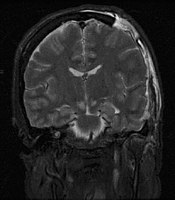
Photo from wikipedia
Background The ultrasound based non-invasive ICP measurement method has been recently validated. Correlation of symptoms and signs of intracranial hypertension with actual ICP measurements in patients with large intracranial tumors… Click to show full abstract
Background The ultrasound based non-invasive ICP measurement method has been recently validated. Correlation of symptoms and signs of intracranial hypertension with actual ICP measurements in patients with large intracranial tumors is controversial. The purpose of this study was to assess ICP in patients with brain tumors, presenting with neurological signs and symptoms of elevated ICP and to further evaluate the value and utility of non-invasive ICP monitoring. Methods Twenty patients underwent non-invasive ICP measurement using a two-depth transcranial Doppler ultrasound designed to simultaneously compare pulse dynamics in the proximal (intracranial), and the distal (extracranial) intraorbital segments of the ophthalmic artery through the closed eyelid. Results Forty-eight measurements were analyzed. Radiological characteristics included tumor volume (range = 5.45–220.27cm 3 , mean = 48.81 cm 3 ), perilesional edema (range = 0–238.27cm 3 , mean = 74.40 cm 3 ), and midline shift (mean = 3.99 mm). All ICP measurements were in the normal range of 7–16 mmHg (ICP mean : 9.19 mmHg). The correlation of demographics, clinical and radiological variables in a bivariate association, showed a statistically significant correlation with neurological deficits and ICP max ( p = 0.02) as well as ICP mean ( p = 0.01). The correlation between ICP and neurological deficits, showed a negative value of the estimate. The ICP was not increased in all cases, whether ipsilateral nor contralateral to the tumor. The multivariate model analysis demonstrated that neurological deficits were associated with lower ICP max values, whereas maximum tumor diameter was associated with larger ICP max values. Conclusions This study demonstrated that ICP in patients with intracranial tumors and mass effect is not necessarily increased. Therefore, clinical signs of intracranial hypertension do not necessarily reflect increased ICP.
Journal Title: BMC Neurology
Year Published: 2020
Link to full text (if available)
Share on Social Media: Sign Up to like & get
recommendations!